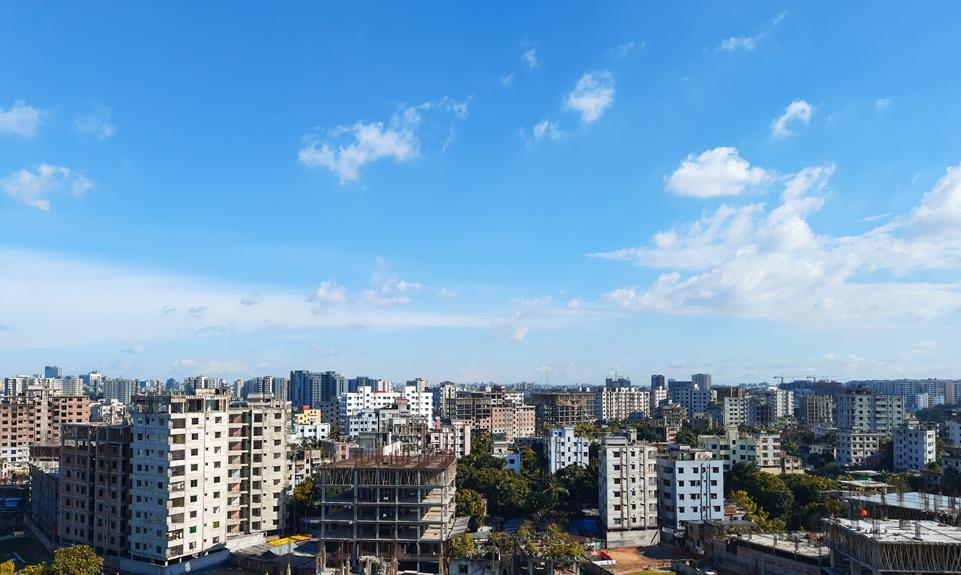Situated in the Rajshahi Division of Bangladesh, Sirajganj District stands as a testament to the rich historical tapestry of the nation. With a name that echoes the legacy of Zamindar Siraj Ali Chowdhury, this district has borne witness to pivotal events in the struggle for independence. From the tragic Salanga Movement to hosting influential conferences organized by prominent political and social groups, Sirajganj has attracted renowned figures and served as a melting pot of diverse communities. Nestled amidst the embrace of major rivers and blessed with a population reflecting a myriad of religions and languages, Sirajganj District holds a captivating tale waiting to unfold.
Historical Significance
The historical significance of Sirajganj District can be traced back to its rich history, which has witnessed significant events and hosted prominent figures that have shaped the course of Bangladesh's past. This district is home to numerous historical landmarks and cultural heritage sites that showcase the region's historical importance. One such landmark is the Zamindar Siraj Ali Chowdhury, after whom the district is named. The Salanga Movement in 1922 is another notable event that occurred in Sirajganj, resulting in a tragic massacre of independence activists. Additionally, the district has been a gathering place for influential organizations such as the All India Congress Party and Brahmo Samaj, who held conferences in Sirajganj. The visit of Kazi Nazrul Islam, the National Poet of Bangladesh, in 1932 further adds to the cultural significance of the district. Lastly, the All-India Muslim League conference in 1942, attended by Muhammad Ali Jinnah, reflects the political importance of Sirajganj in shaping the history of Bangladesh.
Salanga Movement and Independence Activists
Witnessing a tragic massacre of independence activists, the Salanga Movement in 1922 left a lasting impact on the historical landscape of Sirajganj District. The Salanga Movement was a significant event in the struggle for independence in Bangladesh. It was marked by the participation of brave and dedicated independence activists who fought against British colonial rule. These activists played a crucial role in organizing protests, rallies, and strikes to demand freedom and justice. They faced severe repression and violence from the British authorities, culminating in the tragic massacre during the Salanga Movement. The sacrifice and bravery of these independence activists continue to inspire the people of Sirajganj District and serve as a reminder of the price that was paid for the freedom and independence of Bangladesh.
Congress Party and Brahmo Samaj Conferences
The historical impact of the Salanga Movement in 1922 reverberated beyond the tragic massacre, as Sirajganj District became a significant backdrop for conferences held by the All India Congress Party and Brahmo Samaj. These conferences played a crucial role in shaping the political and social landscape of the region. The Congress Party, under the leadership of prominent figures such as Mahatma Gandhi and Jawaharlal Nehru, held conferences to advocate for India's independence from British rule. Their influence in Sirajganj District inspired and mobilized the local population towards the cause of freedom. Similarly, the Brahmo Samaj, a reformist Hindu movement, organized conferences to promote social and religious reforms. Their impact in Sirajganj District fostered a spirit of enlightenment and progressive thinking among the local community.
| Conference | Organizer | Year |
|---|---|---|
| Congress Party | All India | 1922 |
| Brahmo Samaj | Brahmo Samaj | 1925 |
Visit of Kazi Nazrul Islam
Renowned poet Kazi Nazrul Islam made a notable visit to Sirajganj District in 1932, leaving a lasting impact on the cultural and literary landscape of the region. Kazi Nazrul Islam is considered the National Poet of Bangladesh, and his visit to Sirajganj played a significant role in shaping the artistic and literary scene of the district. His influence can be seen in the works of local poets and writers, who were inspired by his revolutionary ideas and poetic style. Kazi Nazrul Islam's visit also sparked a renewed interest in literature and art among the people of Sirajganj, leading to the establishment of literary societies and cultural organizations. Today, Sirajganj continues to celebrate the legacy of Kazi Nazrul Islam and his impact on literature and art in the district.
All-India Muslim League Conference
The All-India Muslim League Conference held in 1942 marked a significant moment in Sirajganj District's history, drawing the attention of political leaders and shaping the course of the independence movement in Bangladesh. The conference showcased the Muslim League's role in advocating for the rights and aspirations of Muslims in British India. It provided a platform for leaders such as Muhammad Ali Jinnah to rally support for the demand of a separate Muslim homeland. The impact of the All India Muslim League conference was profound, as it galvanized the Muslim community and strengthened their resolve for an independent Pakistan. The conference also paved the way for the Lahore Resolution in 1940, which called for the creation of a separate Muslim state. Overall, the All-India Muslim League Conference played a crucial role in shaping the political landscape and the struggle for independence in Sirajganj District and beyond.
Geographic Location and Borders
Located in the Rajshahi Division of Bangladesh, Sirajganj District is situated at the crossroads of several neighboring districts, sharing borders with Bogra, Natore, Pabna, Manikganj, Tangail, and Jamalpur Districts. The district covers an area of 2,497.92 square kilometers and is characterized by diverse geographic features. Sirajganj is traversed by several rivers, including the Jamuna, Baral, Ichamati, Karatoya, Phuljor, and Hurasagor. These water bodies not only contribute to the agricultural productivity of the region but also provide opportunities for transportation and trade. The district's strategic location has also influenced its cultural heritage, as it has been a meeting point for various communities and witnessed significant historical events. Sirajganj's borders with its neighboring districts have facilitated cultural exchanges and the sharing of traditions, contributing to the district's rich cultural tapestry.
Major Rivers of Sirajganj
Situated at the crossroads of several neighboring districts in the Rajshahi Division of Bangladesh, Sirajganj District is blessed with a network of major rivers that not only contribute to its agricultural productivity but also play a significant role in transportation and trade. The main rivers in Sirajganj include the Jamuna, Baral, Ichamati, Karatoya, Phuljor, and Hurasagor. Among these, the Jamuna River holds paramount importance in Sirajganj's economy.
- The Jamuna River, a distributary of the Brahmaputra River, flows through the heart of the district, providing a lifeline for irrigation and navigation.
- The river's fertile banks are ideal for cultivating crops, especially jute, rice, and wheat, which are major contributors to the district's agricultural output.
- The Jamuna River also serves as a major transportation route, facilitating the movement of goods and people, thereby boosting trade and commerce in Sirajganj.
Climate and Weather
Blessed with a diverse range of climatic conditions, Sirajganj District experiences varying weather patterns throughout the year. The district falls under a subtropical monsoon climate, with distinct wet and dry seasons. The average annual temperature ranges from 11.9°C to 34.6°C, providing favorable conditions for agricultural activities. The annual rainfall of 1,610 millimeters ensures an adequate water supply for crops. However, extreme weather events such as cyclones and floods can have detrimental effects on agriculture in the region. These events often lead to crop damage, soil erosion, and loss of livestock. Farmers in Sirajganj District rely heavily on accurate weather forecasts to make informed decisions regarding planting, harvesting, and other agricultural practices. Efforts are also being made to promote climate-resilient farming techniques and implement measures to mitigate the effects of adverse weather conditions on agriculture.
Population and Urbanization
With a population of 3,357,708, Sirajganj District is a vibrant and rapidly urbanizing region in the Rajshahi Division of Bangladesh. The district has experienced significant population growth in recent years, leading to the development of urban areas. This population growth is attributed to various factors, including migration from rural areas and natural population increase. The urban development in Sirajganj District can be observed through the establishment of new infrastructure, such as roads, schools, hospitals, and commercial centers. This urbanization has also resulted in improved access to services and opportunities for the local population. Furthermore, the increasing urbanization has contributed to economic growth and employment opportunities in the district. As Sirajganj continues to grow and develop, it is essential to ensure proper planning and management to sustain the progress and address the challenges associated with urbanization.
Religious and Linguistic Diversity
Sirajganj District in Bangladesh boasts a rich religious and linguistic diversity, reflecting the vibrant cultural tapestry of the region. The district is known for its religious tolerance and cultural heritage, with Islam being the dominant religion, followed by Hinduism. Muslims make up 95.19% of the population, while Hindus account for 4.57%. Other religions, including Christianity and Sarnaism, represent 0.24% of the population. The Hindu population has remained relatively constant, while the Muslim population has steadily increased over the years. In terms of language, the majority of the population in Sirajganj speaks Bengali, with the local dialect being the Sirajganji dialect. The district also has a rich linguistic diversity, with various languages being spoken by different communities.
Frequently Asked Questions
What Is the Significance of the Name "Sirajganj" and Who Is It Named After?
The name 'Sirajganj' holds significant historical value in Bangladesh. It is named after the prominent Zamindar Siraj Ali Chowdhury, who played a crucial role in the development and governance of the region. The name 'Sirajganj' signifies the influence and legacy of Siraj Ali Chowdhury in the district. This naming serves as a reminder of his contributions and the historical importance of the district in the country. The district of Sirajganj has witnessed various significant events and conferences, attracting notable figures like Kazi Nazrul Islam and Muhammad Ali Jinnah.
How Did the Salanga Movement in 1922 Impact the Independence Activists in Sirajganj?
The Salanga Movement in 1922 had a significant impact on the independence activists in Sirajganj. It played a crucial role in the Sirajganj independence movement by mobilizing and uniting the local population against British colonial rule. The movement resulted in a massacre of several activists, demonstrating the determination and sacrifice of those fighting for independence. The Salanga Movement became a symbol of resistance and inspired further protests and movements in the region.
What Were the Key Discussions and Outcomes of the Conferences Held by the All India Congress Party and Brahmo Samaj in Sirajganj?
The conferences held by the All India Congress Party and Brahmo Samaj in Sirajganj were significant in shaping the political discourse of the time. Key outcomes included discussions on Indian independence, socio-economic reforms, and religious harmony. Prominent leaders played a crucial role in advocating for these causes and uniting people from diverse backgrounds. The conferences provided a platform for intellectual exchange, fostering a sense of nationalism and inspiring future generations to strive for a free and inclusive India.
What Was the Purpose of Kazi Nazrul Islam's Visit to Sirajganj in 1932 and What Impact Did It Have?
Kazi Nazrul Islam visited Sirajganj in 1932 with the purpose of inspiring and mobilizing the local population through his poetry and speeches. His visit had a significant impact on the people of Sirajganj, as he was able to rally support for the independence movement and instill a sense of pride and nationalism among them. Nazrul Islam's visit played a crucial role in fostering a spirit of resistance and unity, contributing to the overall movement for independence in Bangladesh.
What Role Did Muhammad Ali Jinnah Play in the All-India Muslim League Conference Held in Sirajganj in 1942?
Muhammad Ali Jinnah played a significant role in the All-India Muslim League conference held in Sirajganj in 1942. As the leader of the Muslim League, Jinnah advocated for the rights and interests of Muslims in British India. His presence at the conference helped to mobilize support for the Muslim League's demand for a separate Muslim state, which eventually led to the creation of Pakistan. Jinnah's influential role in the conference had a profound impact on the political landscape of the region.





